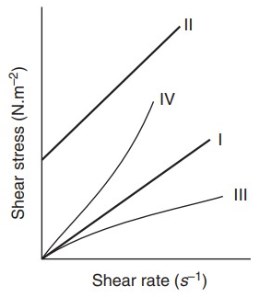42. Measurement of KLa in a bioreactor can be carried out by sodium sulfite oxidation method, that is, based on the oxidation of sodium sulfite to sodium sulfate in the presence of a catalyst (Cu++ or Co++). In a typical experiment, a laboratory fermenter was filled with 5 liter of 0.5 M sodium sulfite solution containing 0.003 M Cu++ ions and the air was sparged in. After 10 min, the air flow was stopped and a 10 mL sample was taken and titrated. The concentration of sodium sulfite in the sample was found to be 0.20 M. The oxygen uptake rate for this aerated system will work out to be
43. In a well aerated and agitated microbial culture, the 'supply' of oxygen is equal to 'demand' (uptake) of the growing culture. The KLa for such a system will be (KLa = volumetric mass transfer coefficient, C* = dissolved oxygen concentration in liquid in equilibrium with gaseous oxygen, C = instantaneous value of dissolved oxygen concentration, 'r' = specific oxygen uptake rate per unit weight of cells, X = dry weight of the cells per unit volume)
44. Glycogen is a branched polymer of glucose It has
45. Shear stress versus shear rate behavior of four different types of fluids (I, II, III and IV) are shown in the figure below.

Which one of the following options is correct?

Which one of the following options is correct?
46. If the frequency of males affected with an X-linked recessive condition in a human population is 0.10 (one in ten), what will be the expected frequency of affected females?
47. Power number also called Newton's number, is defined as a dimensionless parameter relating to
48. In the meiosis type cell division, chromatids segregates during
49. Binding of mannose 6-Phosphate to protein lead to its localization to
50. In mammalian cells, RNA editing
P. Can change the coding capacity of a gene after transcription
Q. Creates a stop codon in the middle of the apo-B mRNA in intestinal cells but not in liver cells
R. Usually makes many changes in each mRNA
S. Can change specific nucleotides by deamination
P. Can change the coding capacity of a gene after transcription
Q. Creates a stop codon in the middle of the apo-B mRNA in intestinal cells but not in liver cells
R. Usually makes many changes in each mRNA
S. Can change specific nucleotides by deamination
